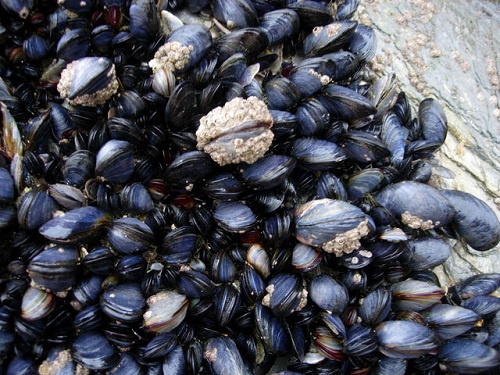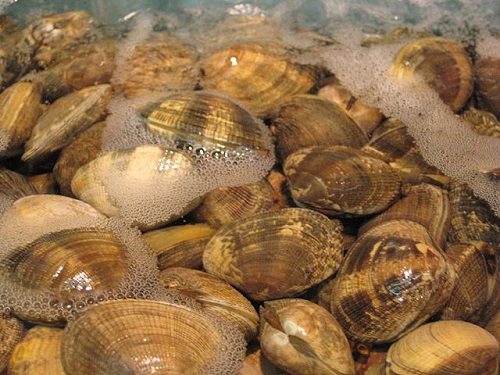Difference Between Mussels and Clams

Mussels
Mussels vs. Clams
When it comes to shellfish, many people wonder about the difference between a mussel and a clam. Although the two come from a similar family – the bivalve family – they are considered as different species.
Mussels are for members of bivalvia mollusca that come from saltwater and freshwater. Members of this group have a shell with an outline that is elongated and asymmetrical, and are less oval or circular in shape. The word “mussel” indicates it is an edible bivalve that comes from the marine family Mytilidae. Oftentimes they live in shores by the intertidal zone. They are strongly attached with the help of their byssal threads so that they can form a firm substrate. Additionally, there are a few species that have inhabited the hydrothermal vents that are connected with deep ocean ridges. Most of the marine mussels’ shell is longer, wedge-shaped, or asymmetrical. The external color would be dark blue, brown, and black, but the insides would be silver or grayish and look nacreous.
As for clams, they are freshwater bivalves. Generally speaking, they are bivalve mollusks. But if you consider it in a much more limited sense, clams are the bivalves that hide away in sediments. They aren’t like mussels, which usually attach themselves to the substrate. Moreover, clams are one or more species that are commonly consumed; many indulge in the dish called clam chowder. There are a lot of edible bivalves that are oval in shape; however, razor clams are edible and have an elongated shape with a parallel-sided shell. The shape looks like an old-fashioned straight razor. It is different in the United Kingdom – there, they are coined as the various species of marine bivalve mollusk.

Clams
The anatomy of these bivalves is completely different. The external shell of a mussel has two hinged valves. The valves are connected on the outside by a ligament. They close with the help of strong internal muscles. You would be surprised to know that mussel shells actually carry a lot of functions: providing support for tissues, protection from predators, and desiccation. The shell is composed of three layers – the iridescent layer, prismatic layer, and the periostracum. In pearly mussels, the iridescent layer is made up of calcium carbonate secreted consistently by the mantle. The prismatic layer, which is the middle layer, is composed of white, chalky crystals of calcium carbonate covered in a protein matrix. The periostracum is the outer pigment layer and is similar to skin. It has conchin that contains protein, which serves as protection from abrasions and dissolutions by acids.
Conversely, clams have a shell that contains two equal halves or valves. These clams are joined together by a hinge join and a ligament. It can either be external or internal, similar to that of a Venus flytrap. Clams have two adductor muscles that allow the shell to close as it contracts. Clams have no heads; however, they have kidneys, a heart, a mouth, and an anus. Moreover, clams have open circulatory systems; they have organs that are surrounded by watery blood. This blood contains the nutrients and oxygen needed for their survival. Clams eat plankton through the process of filter feeding, which happens by drawing in water containing food via a siphon system. As the food is filtered out of the water with the use of gills, it is swept toward the mouth on the layer of mucus. Finally, water is expelled by the animal from another siphon system.
Summary:
1. Mussels come from a bivalve family and attach to a substrate with the help of byssal threads.
2. Clams are bivalve mollusks that burrow themselves into the sediment.
3. The shells of a mussel have three different layers: the iridescent layer, prismatic layer, and periostracum.
4. Clams’ anatomy is more complex as it includes a kidney, heart, mouth, and anus.
- Differences Between Fraternity And Sorority - January 8, 2014
- Differences Between Lucite and Plastic - January 7, 2014
- Differences Between Oil and Butter - January 6, 2014
Search DifferenceBetween.net :
4 Comments
Leave a Response
References :
[0]https://en.wikipedia.org/wiki/Mussel
[1]https://en.wikipedia.org/wiki/Clam

Almost none of this is correct, it would take more work to fix it than would be worth fixing it is so inaccurate, all of this should be erased. -a mussel ecologist
Please detail
This is so wrong. For one a clam is not only freshwater but is more commonly saltwater.
Clams are more commonly Saltwater than Freshwater (greater species variety is found in saltwater). The few species found in freshwater, aren’t typically called Clams in freshwater, they’re referred to as Bivalves Molluscs. Of the 5600+ known species of Bivalves Molluscs, only 270 (as of 2010) are freshwater species, the vast majority are Marine or Brackish water species. The most common food production clam species are all saltwater species.